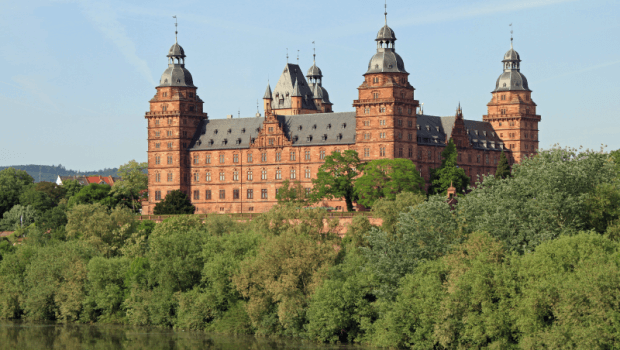
Schloss Johannisburg or the Johannisburg Palace used to perform the role of being the second residence of the Archbishop of the Electorate of Mainz till about the year 1803. The palace is located right on the banks of the river Main and is also quite centrally situated in Aschaffenburg.
Schloss Johannisburg has been constructed in such a manner that it projects a mighty countenance and comprises of a four-winged complex. The palace was built between 1605 and 1614 at the hands of Georg Ridinger, an architect hailing from Straßburg, the capital city of the Alsace region in the north eastern region of France. Prior to the Schloss Johannisburgs construction there used to be a castle belonging to the medieval era, constructed sometime in the 14th century. The very foundation of Schloss Johannisburg was based and constructed over this 14th century medieval castle. Through this integration one of the most important palaces belonging to the German renaissance was created. The interior of the palace was changed with respect to the classicist style which was prevalent in the late 18th century. It was laid out as per the plans drawn by Emanuel Joseph v. Herigoyen.
The spirit of the palace survived through many centuries and when it reach the violent 1900’s it was met with the catastrophe of the World Wars. During World War II it was met with serious damage. However the repair works did begin almost immediately as the war ended. But it was mostly concentrated on the exterior at first.
Towards the end of the year 1964 with the help of the Bayerische Schlösserverwaltung or the Bavarian Palace Administration was able to complete most of the renovation work. During that year the exhibition rooms along with its collections such as: the palace church which comprised of the Renaissance altar, the chancel, and the portal sculpture made by Hans Juncker dating back to the early parts of the 17th century, certain vestments which belonged to the former cathedral treasury of the Mainz along with the magnificent residential rooms and the largely undamaged classicist furnishings – all of these were made open for public viewing.
Among the most fascinating items that are present on display is the largest collection in the world of architectural models which are made out of corks. These models area simply extraordinary and were made in 1792 by the then court confectioner Carl May and Georg May, his son. These models depict the famous ruins of Rome. In the year 1996 these models were shifted to newly decorated rooms.
Some snippets
The town of Aschaffenburg is located in Franconia, a state in the Bavarian region of Germany. The construction of Schloss Johannisburg lasted almost a decade and much of the construction work was conducted between 1605 and 1614. Its architect: Georg Ridinger was essentially a German architect and builder affiliating to the traditions of the late Renaissance period and the early Baroque styles.
Georg Ridinger during his early parts of life had travelled extensively throughout France and Italy where he studied especially the architectural styles of the many fortresses there. When he returned to the German Reich, he came back as an enthusiastic man. Among his early endeavours was the Schloss Philippsburg in Koblenz. Moreover, his most appreciated and respected works were performed on the Johannisburg Castle. He was appointed at the request of the Archbishop and Elector Johann Schweikard of Kronberg on the 13th of March 1607. This palace was to become the Archbishops second residence. Most of the construction work was finished by 1614 and thus it was inaugurated that year as well. However, it could only finally be completed by the end of 1618 and beginning of 1619. The building comprises of red sandstones which was the typical material used in construction in those days. This material was sourced from the hills which are located near to Aschaffenburg.
Johannesburg Palace quite literally dominates the landscape of the city through its mighty and solid imposition. Thus indeed it is truly regarded as the greatest attraction of the city. A popular saying goes like this: The city is her castle.
A bit of History and everything else
Johannisburg Palace was built on the keep of a 14th century fortification which existed on the same very spot. Furthermore, keep or kype are kinds of fortified towers which were typically built within the castle itself during the Middle Ages. Scholars have managed to unearth the reasons behind these towers. They used to be erected as a matter of last resort for refuge in case the castle was breached by certain adversaries. The very design of the keep changed in the 12th century prior to which it was made using timber. Later-on they were modelled to resemble a quatrefoil-shape which was developed in France. However, another form which was quite prevalent but largely limited to England was the polygonal towers.
In Germany particularly these keeps are called: Bergfried. They have been described as freestanding, fighting towers. As was said above, their primary function was to defend the castle. They were not meant for prolonged habitation in any case. In Schloss Johannisburg the keep can be found in its oldest section.
Records have also shown that the initial design of the earlier fortification was based on certain drawings made by Veit Hirsvogel the younger. Moreover, as far as the location is concerned, it is also of a considerable importance. It was also the same place where Albrecht of Brandenburg , archbishop of Mainz and Magdeburg came together as an assemblage right after the Reformation in 1539.
The 14th century medieval structure fell during the lootings after the Markgräfler War in 1552. Albrecht of Brandenburg had earlier brought in many magnificent art pieces and they too were looted. At the time of the construction of Schloss Johannisburg, Ridlinger just used the large Gothic keep and demolished rest of the ruins. This keep became the fifth tower right in the centre of the north western wing of the palace.
As far as the main building is concerned it has been kept strictly symmetrical and its outside dimensions are: 87.5 m by 86 m. The main construction material used in the process was Odenwald sandstone. These varieties of the red sandstone can be found in the east and south eastern area of the Odenwald. Geologically speaking, in this region you can find sand, silt and shales all of which has resulted in the formation of low to pale red sandstones. There used to be a lake here nearly 250 million years ago and thus the many deposits and sedimentation.
The 52 metres high corner towers are nearly eight stories high and they also correspond with the width of each of the three storied wings. There is also a square shaped courtyard which has a length of 51 metres. Schloss Johannisburg was the second residence of Prince Bishop of Mainz till the end of the ecclesial princedoms in Germany in 1803. This period was marked by a considerable amount of territorial restructuring which took place between 1802 and 1814 in Germany along with the neighbouring regions as well. It was conducted through mass mediatisation and secularisation of many of the Imperial Estates. The Imperial Estates included: ecclesiastical principalities, free imperial cities, secular principalities along with other smaller self-ruling entities that lost or forgone their independent status and thus were absorbed into the remaining states. What this means is that these regions were simply absorbed into another state.
It is important to remember that the mediatisation process was not at first a German cause. It came into effect as a result of the diplomatic pressures that emerged as a result of the revolutionary France and Napoleon. In Germany this period saw the most extensive redistribution of property and territories prior to 1945.
Thus the Principality of Aschaffenburg was created in 1803 and Karl Theodor von Dahlberg the Archbishop of Mainz was also able to retain his said territory of Aschaffenburg. This principality also came to include some other territories as a matter of compensation because Mainz was annexed by France. Aschaffenburg furthermore, remained a part of the Grand Duchy of Frankfurt for a period of three years between 1810 and 1813. Later-on, Aschaffenburg along with Schloss Johannisburg came under the jurisdiction of the Kingdom of Bavaria.
When Ludwig I ruled the region Schloss Johannisburg became his summer residence. Ludwig I, as has been historically recorded, would often refer to Aschaffenburg as his Bavarian Nice. Ludwig I also decreed the construction of Pompejanum, a Roman Villa within the sight of the palace.
Schloss Johannisburg is regarded as the landmark of Aschaffenburg and its main attraction. Along with this it is also a crucial building hailing from the German Renaissance period, historically speaking. Within the palace you will be able to visit a gallery comprising of paintings Staatsgalerie Aschaffenburg, this gallery also hosts works done by Lucas Cranach the Elder. Furthermore, there are also the many residential rooms which have been furnished in neoclassical styles along with the Municipal Palace Museum of arts and handicraft, the Paramentenkammer of the palace chapel which carries vestments from the former treasury of Mainz Cathedral. Possibly the main feature of this historical tour would definitely be the world’s largest collection of architectural models which have been made from cork and was built by the confectioner Carl May and his son in and around 1792. There are about 45 models in total and since 1996 they have been put on display in specially redesigned rooms. It is the largest and one of a kind collection in the whole world.
When you embark upon the tour of the palace make sure that you visit the State Gallery. It houses some of the most amazing pieces from Old Germany and Dutch Art. The Palace Museum actually belongs to the town to the town of Aschaffenburg and houses certain impressive pieces of art ranging from medieval sculptures and valuable furniture’s along with ceramics and paintings by Christian Schad.
Towards the conclusion of the tour, you will be taken for a walk into the beautiful palace garden and then to Pompeiianum. Also, another fascinating visit could be of that of the main terrace. The panoramic view from this point of the entire Main river valley is simply awe-inspiring. This path then continues towards an attractive pergola which as a matter of fact runs above a section of the original medieval town wall. Then you will cross a slightly elevated plain and reach the site of the neoclassical Breakfast Temple. It was designed in 1782 by von Herigoyen. Right behind it is the last remaining section of the former town moat. This moat was redesigned in the form of a landscape garden in the 1780s by Friedrich Ludwig Sckell on behalf of the Archbishop and Elector of Mainz, Friedrich Carl von Erthal.
Following is a list of sites within the palace compound which are available for public and private events:
- Ridingersaal or The Ridinger Hall: This hall can seat up to 200 individuals and has been used for hosting concerts, exhibitions, receptions and banquets.
- Turmzimmer or The Tower Room: This room can seat up to 100 people and is suitable for receptions and banquets.
- Treppenhalle or The Staircase Hall: Ideal for receptions and can host 120 people.
- Schlosskapelle or The Palace Chapel: Suitable for religious services, catholic weddings and concerts. It can house 112 people.
- Schlosshof or The palace courtyard: This courtyard is ideally suitable for large concerts or receptions and can easily accommodate 6000 people.
Opening hours
- April to September: 9.00–18.00
- October to March: 10.00–16.00
- The palace is closed on Mondays, and also
- Closed on 1 January, Shrove Tuesday, 24, 25 and 31 December.
